Did you know that untreated garage floors exposed to winter salt and slush can deteriorate up to 50% faster? That’s right – winter conditions don’t just make your garage messy; they trigger long-term damage that leads to costly repairs, unsightly floors, and safety hazards. This guide reveals the critical steps every homeowner must take for winter garage floor care (salt, slush) – from prevention to repair – so you can protect your investment before lasting harm sets in.
Winter Garage Floor Care (Salt, Slush): Why It Matters More Than You Think
"Did you know that untreated garage floors exposed to winter salt and slush can deteriorate up to 50% faster?" – National Garage Safety Institute
Ignoring winter garage floor care (salt, slush) is a recipe for disaster inside your garage. When snow melts or slushy boots cross the concrete, the resulting salty water eats away at the surface. The chemical reaction from road salt accelerates cracks and pits, leading to uneven floors and, eventually, serious structural issues. If you're keeping your garage floor clean but not protected, heavy foot traffic and car tires will only grind the damage deeper into the surface. Over time, what begins as simple salt stains or minor etching can develop into widespread concrete deterioration, inviting mold, mildew, and even damaging the belongings you store in your garage. In essence, protecting your garage floor isn’t just about neatness; it’s about avoiding costly repairs and extending the lifespan of your property.
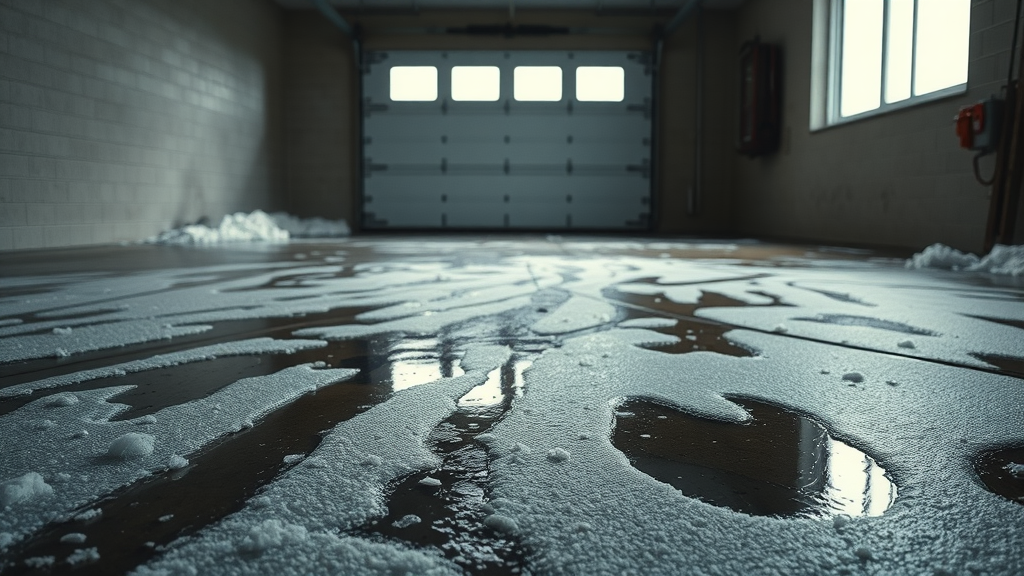
Protect Your Garage: Understanding the Impact of Salt and Slush
Salt and slush seem harmless when inside your garage, but their long-term effects can be alarming. Salt essentially breaks the protective layer of concrete or floor coatings, allowing water and melted snow to seep in. When temperatures drop, this moisture expands and contracts, causing your garage floor to crack and flake even faster. The problem compounds with each cycle of snow and ice tracked in by cars and foot traffic. Even if your floor looks clean, the chemicals from de-icing products penetrate deep into the surface. Polyaspartic floor and epoxy coat systems offer some protection, but no floor is immune without regular maintenance and a proactive strategy to keep your garage floor clean throughout winter.
Keeping Your Garage Floor Safe During Winter Months
Keeping your garage floor clean during the harsh winter months involves more than a quick mop. First, routinely sweep away salt granules, melted snow, and debris. Next, use absorbent mats at both car entry points and near the garage door to capture majority of the slush and chemicals before they reach exposed concrete. For garages with heavy foot traffic or frequent use, a regular cleaning routine prevents build-up and reduces the amount of salt and moisture sitting on your floors. Don’t forget to inspect your floor coating for chips and cracks—addressing small problems early can prevent major, costly repair jobs as winter wears on.
Hidden Costs of Neglecting Winter Garage Floor Care (Salt, Slush)
Overlooking winter garage floor care doesn't just result in a dirty floor; it leads to expensive and sometimes unavoidable consequences. The most common hidden cost is significant surface damage from repeated salt exposure, which weakens both coated and bare concrete surfaces. This deterioration leads to the necessity of resurfacing or completely replacing your garage floor, a project that can cost thousands. Mold and mildew from persistent moisture may also threaten your health and that of your family, hiding in garage corners and storage areas until discovered. If you use your garage as a workshop or entryway, consider how floor damage impacts resale value and indoor air quality in your home. Simply put, regular maintenance and proactive measures for winter garage floor care (salt, slush) will save you substantial time, frustration, and money in the long run.
What You'll Learn About Winter Garage Floor Care (Salt, Slush)
- The science behind winter garage floor damage
- Proven strategies for keeping your garage floor clean and protected
- Product comparisons: floor coatings, mats, and more
- Step-by-step winter garage floor care (salt, slush) maintenance guides
- Expert answers to top-seasonal questions
The Science Behind Winter Garage Floor Care (Salt, Slush) and Damage
How Salt, Slush, and Snow Melt Chemicals Affect Your Garage Floor
Salt, slush, and snow melt chemicals impact garage floors in ways most homeowners underestimate. When road salt mixes with melted snow, it forms a corrosive brine that seeps into even the smallest pores and cracks of your garage floor. This chemical reaction gradually erodes the integrity of concrete and can break down the protective layer of epoxy coat or polyaspartic coatings over time. In climates with frequent snow and ice, this cycle of wetting and drying, freezing and thawing, creates internal pressure that causes chips, spalling, and even deep cracks on concrete surfaces. Polyaspartic floor coatings are highly resistant but not immune to severe or repeated chemical exposure. If your garage floor is left unprotected, you might notice visible salt stains or a powdery residue that feels gritty underfoot—a clear sign of ongoing deterioration. Regular cleaning is necessary to prevent small issues from becoming damage that requires costly repair.
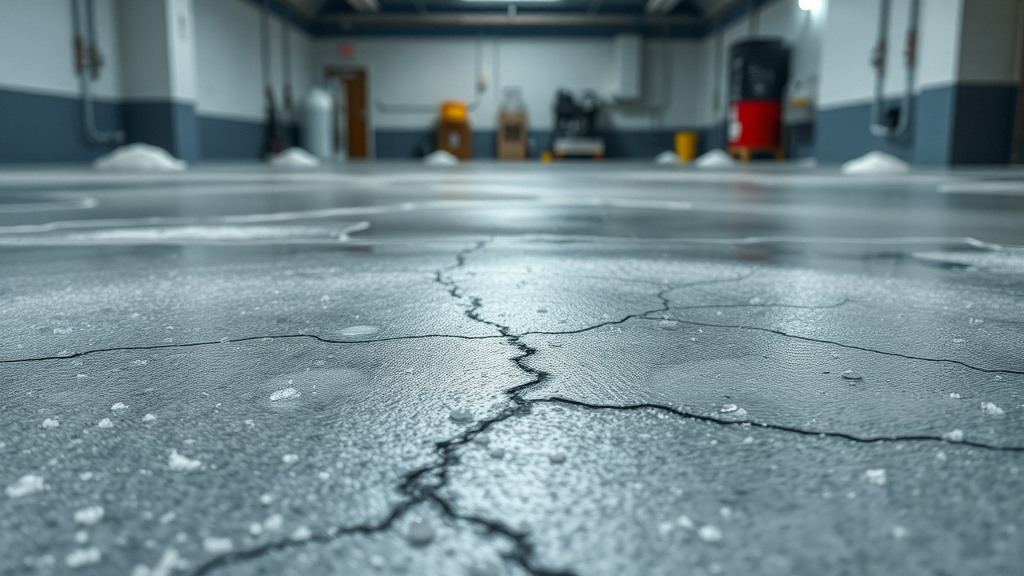
Seasonal Changes and Their Influence on Garage Floor Clean-Up
Seasonal shifts magnify the challenges of winter garage floor care (salt, slush). Each time temperatures move above and below freezing, moisture within your garage floor expands and contracts. This process breaks down both the concrete surface and any applied floor coating, allowing chemicals like road salt to penetrate even deeper. Early winter brings wet slush and constant snow melt, while late season often features drier salt buildup. Each stage demands a slightly different cleaning approach: in wet conditions, more frequent mopping and use of absorbent mats; in dry and cold periods, intense scrubbing to remove stubborn salt stains. Even if you keep your garage floor clean, heavy foot traffic and car tires may reintroduce contaminants, so a seasonal cleaning schedule is essential to maintain both cleanliness and floor integrity. Proactively scheduling deeper cleaning routines after major snowstorms or road-salting events will keep damage from compounding.
| Epoxy Coat | Polyaspartic Floor | Concrete | |
|---|---|---|---|
| Salt Resistance | High (with regular maintenance) | Very High (best-in-class) | Low (uncharted) |
| Slush Protection | Resists minor pooling | Excellent against long-term slush | Poor – absorbs and stains |
| Ease of Cleaning | Easy; non-porous | Very easy; resists sticking | Difficult; porous, needs frequent scrubbing |
| Lifespan with Winter Exposure | 3–7 years | 8–15 years | 1–4 years (with heavy salt/slush) |
| Initial Cost | $$ | $$$ | $ |
Keeping Your Garage Floor Clean: Step-by-Step Winter Cleaning Guide
Essential Tools and Products for Winter Garage Floor Care (Salt, Slush)
A successful winter garage floor care routine (salt, slush) starts with the right tools and cleaning supplies. First, invest in a sturdy shop broom to sweep away loose debris and salt granules. For tougher, stuck-on messes, a stiff-bristled brush is necessary to scrub the surface without damaging floor coatings. A mop or wet/dry vacuum will help remove residual melted snow and chemical brine. Squeegees are invaluable for pushing water, slush, and cleaning solutions toward the garage door, reducing standing moisture. Use dedicated garage floor cleaning solutions formulated specifically to break down road salt and protect finishes without harming your floor. Containment mats or heavy-duty floor mats at entryways significantly reduce the amount of slush and salt spread throughout the garage – capturing contaminants before they can reach vulnerable floor areas. These essential products ensure you’re equipped to keep your garage floor clean throughout the dangerous winter season.
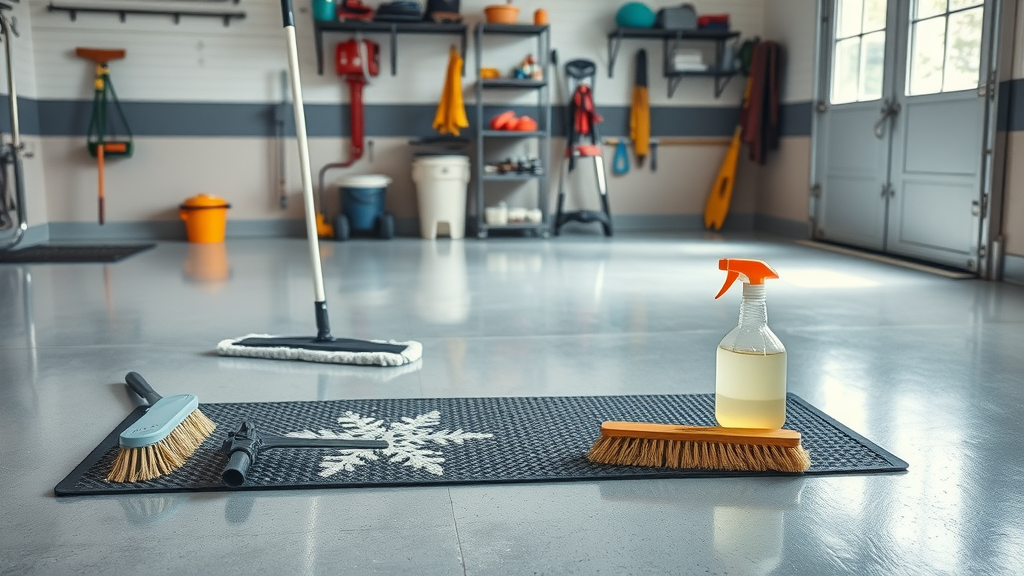
DIY Garage Floor Clean-Up vs. Professional Services
When it comes to keeping your garage floor clean in winter, homeowners can choose between DIY solutions and hiring professional cleaning services. DIY cleaning allows you to tailor routines based on your schedule and the specific challenges of your garage environment. Simple tools and cleaning agents, along with regular attention, can prevent salt stains and keep floor coatings intact. However, if you find persistent salt damage, severe staining, or lack the time/expertise, professional services may be worth considering. Professionals bring specialized equipment for deep cleaning slush and salt, and assess any hidden issues that may lead to costly repair if left untreated. A hybrid approach also works well: routine weekly cleaning yourself, supplemented by professional deep cleans once or twice each winter – especially before and after major snow melt periods. Whatever route you choose, the most important factor is consistency in your garage floor care routine.
- Floor mats vs. containment mats
- Popular cleaning solutions for garage floors
- Tips for regular garage floor clean routines
Protect Your Garage Floor: Preventive Measures Before and During Winter
Pre-Winter Floor Coating Options: Epoxy Coat vs. Polyaspartic Floor
Applying a durable floor coating is one of the best investments you can make in winter garage floor care (salt, slush). Two of the most popular choices are epoxy coat and polyaspartic floor systems. An epoxy coat provides a tough, glossy barrier, preventing moisture and salt from penetrating the concrete surface. It cures slowly, offering time for precision in application, but requires ambient temperatures above freezing to avoid defects. Polyaspartic coatings, on the other hand, set very rapidly and can be installed in colder conditions, making them ideal even in late fall or early winter. Polyaspartic floors are also more resistant to chemical spills and UV exposure, with a longer typical lifespan than epoxy. Both coating types minimize salt damage and make regular cleaning much easier. Applying coatings before the first snow and ice arrives significantly reduces the risk of costly repair—choose the system that fits your climate and installation window best.
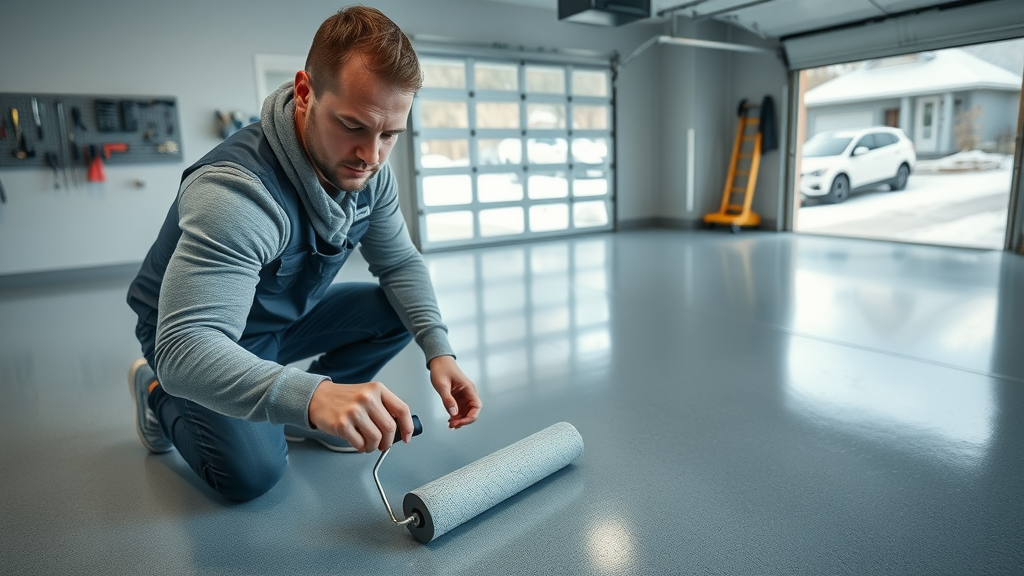
"Floor coatings can extend the life of your garage floor by years when applied before winter." – Garage Coatings Expert
Using Containment Mats and Floor Mats for Garage Floor Cleanliness
Containment mats and specialized floor mats are essential in winter garage floor care. Containment mats, with raised edges, trap melted snow, slush, and chemicals – stopping them from spreading onto your garage floor. Place these mats under vehicles and near any entryways with frequent foot traffic to catch contaminants before they reach your floor's surface. Standard floor mats work well for capturing lighter moisture and grit, especially in car parking zones or work areas. For even greater protection, combine mats with a consistent garage floor cleaning routine. Not only do these products make regular cleaning easier, but they also preserve residential garage floors from premature wear, protecting your garage floor investment all season long.
Installation Tips for Garage Door Thresholds to Prevent Snow Melt Ingress
Installing a garage door threshold seal is a simple yet highly effective winter garage floor care tactic. A well-chosen threshold blocks exterior snow melt and slush from seeping under the door and pooling near your concrete or floor coating. Choose a heavy-duty, weather-resistant rubber material and ensure the threshold extends the full width of your garage door. Installation typically requires strong adhesive and accurate placement—test fit before securing permanently. Combine this with regular inspections of your door seal to prevent drafts, minimize heat loss, and keep unwanted moisture outdoors. These small steps can significantly reduce winter floor damage and keep your garage warmer and drier.
Dealing with Salt Build-Up and Slush: Garage Floor Maintenance Tips
Immediate Actions When Salt or Snow Melt Spills Occur
Reacting quickly to salt spills and melted slush is a cornerstone of effective winter garage floor care (salt, slush). The longer salt and slushy water sit on your floor, the more time they have to cause damage, especially on porous or cracked surfaces. As soon as you see a spill, grab a dry absorbent material—such as kitty litter or specialized garage floor absorbent—to soak up liquid. Sweep or vacuum up the dirty mix, then mop or rinse with a gentle, non-corrosive cleaning solution. For floors with a polyaspartic or epoxy coat, prompt cleanup prevents chemicals from eating through the protective layer. If needed, repeat with a squeegee to keep the area as dry as possible. This fast response routine should become part of every winter cleaning schedule, whether you have a bare concrete surface or a sealed, coated garage floor.
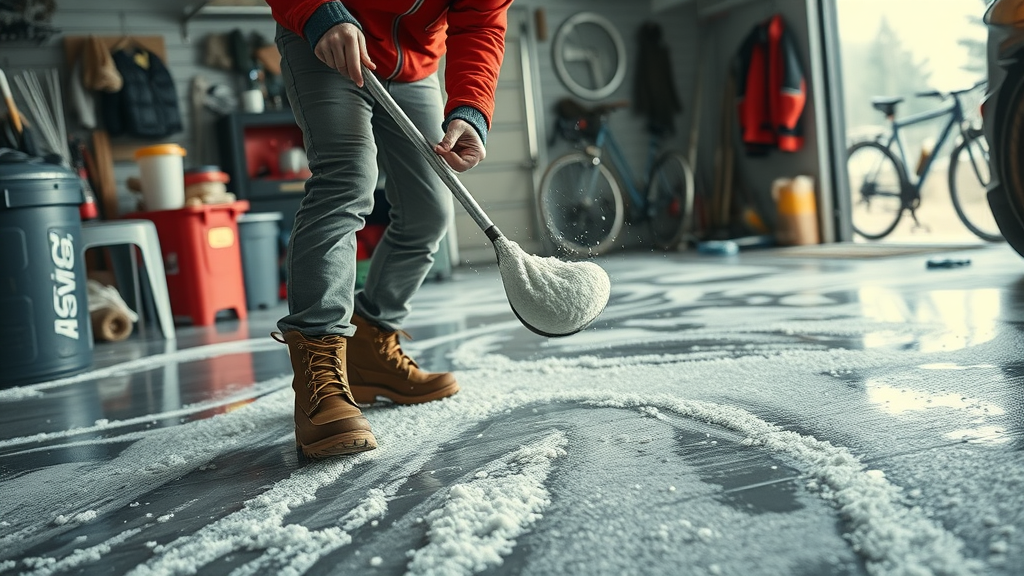
Best Maintenance Schedules for Winter Garage Floor Care (Salt, Slush)
Consistent maintenance is what separates lasting winter garage floor care (salt, slush) from a springtime disaster restoration project. During heavy winter months, aim to sweep or vacuum your floor twice a week, focusing on corners and high-traffic areas where salt tends to build up. Mop or power wash monthly if temperatures allow, or as often as you notice visible buildup. Inspect mats and thresholds for wear, clean under them weekly, and don’t forget to spot treat fresh salt stains immediately. Schedule a deep clean and inspection at the start and end of each winter, ensuring your floor coatings and protective seals are in good condition. This schedule is especially important for households with heavy foot traffic, multiple vehicles, or where the garage door opens frequently during storms. Even quick jobs – like five-minute spot cleanups – can significantly reduce the overall risk of concrete or floor coating damage caused by ongoing salt and snow melt exposure.
How to Fix Garage Floor Damage from Salt and Slush
Spot Repairs for Concrete and Floor Coating
Despite best efforts, winter can sometimes leave your garage floor with visible damage: pitted spots, flaked coatings, or discolored patches. For minor issues on bare concrete, begin by cleaning and drying the area, then use a concrete patching compound to fill holes or cracks. Sand smoothly after it dries to create a seamless finish. For floors with an epoxy or polyaspartic coat, carefully sand down the impacted section (following manufacturer’s recommendations), clean all debris, then reapply a matching batch of the same floor coating. Quick repairs will not only stop further damage from salt and moisture but also restore the integrity of your protective layer. Make sure any repair work is done in a warm, dry garage for best results – and never skip the crucial step of applying fresh sealant after repairs to prevent a repeat of the problem.
When to Call a Professional: Extreme Damage and Polyaspartic/Epoxy Coat Repairs
If you're facing widespread chipping, multiple deep cracks, or large patches of coating that have lifted from the surface, it’s time to call in a garage floor professional. Extreme salt damage may require complete resurfacing or even removal and replacement of deteriorated concrete. Professionals have access to industrial-grade cleaning products, smoothing tools, and high-performance coatings—especially important for polyaspartic and advanced epoxy systems—that can achieve a flawless, long-lasting restoration. Don’t wait until minor winter damage escalates to a major, costly repair situation. If unsure, schedule a seasonal inspection to catch floor issues before they reach this stage; a modest up-front investment in professional input can save thousands in potential repairs later on.
Winter Garage Floor Care (Salt, Slush): Expert Recommendations
- Top-rated garage floor clean products: Choose pH-neutral cleaners designed for concrete, as well as absorbent and easy-to-clean mats.
- Benefits of seasonal garage floor inspections: Detect small issues before they become expensive; inspect coatings, mats, and garage door seals.
- Budget-friendly preventative tips: Regular sweeping, using old towels for minor spills, and DIY patch kits for chips and cracks.
"Keeping your garage floor clean in winter can save major repair costs in spring." – Facility Maintenance Specialist
People Also Ask: Winter Garage Floor Care (Salt, Slush) Essentials
How to Keep Your Garage Floor Clean in the Winter?
Answer: Regular sweeping, prompt removal of slush and salt, applying a durable floor coating, and using containment mats are effective ways to keep your garage floor clean in the winter.
How to Protect Garage Floor from Salt?
Answer: Applying epoxy or polyaspartic floor coatings, sealing cracks, and placing mats at entryways are reliable methods for protecting your garage floor from salt damage.
How to Dry Out a Garage Floor in Winter?
Answer: Use floor squeegees, industrial blowers, or dehumidifiers to quickly dry out wet garage floors, and address sources of water ingress such as weak garage door seals.
How to Keep Garage Floor Warm in Winter?
Answer: Install insulated flooring, use space heaters designed for garages, or consider radiant floor heating systems for optimal winter comfort.
FAQs: Winter Garage Floor Care (Salt, Slush)
- Can you pressure wash your garage floor in winter? Only if your garage is climate-controlled or temperatures are above freezing; otherwise, risk of ice formation and additional damage.
- What is the best garage floor coating for winter protection? Polyaspartic is generally preferred for its fast cure and chemical resistance, but high-quality epoxy is a strong alternative when installed properly.
- Do containment mats really prevent slush tracking? Yes, containment mats with raised edges are extremely effective at capturing melted snow, slush, and salt, significantly reducing their spread.
- How often should I reseal my garage floor? Every 2–4 years depending on exposure and coating type; inspect annually for signs of wear.
- Will regular salt exposure ruin my garage floor over time? Yes, without protective coatings and proper cleaning, repeated exposure will accelerate deterioration of concrete and coatings alike.
Key Takeaways: Efficient Winter Garage Floor Care (Salt, Slush) Strategies
- Promptly remove slush and salt buildup from garage floors.
- Invest in durable coatings: epoxy or polyaspartic for optimal protection.
- Use floor mats and containment mats to maintain cleanliness.
- Schedule seasonal inspections for early floor damage detection.
- Tailor solutions to your garage’s unique needs and usage patterns.
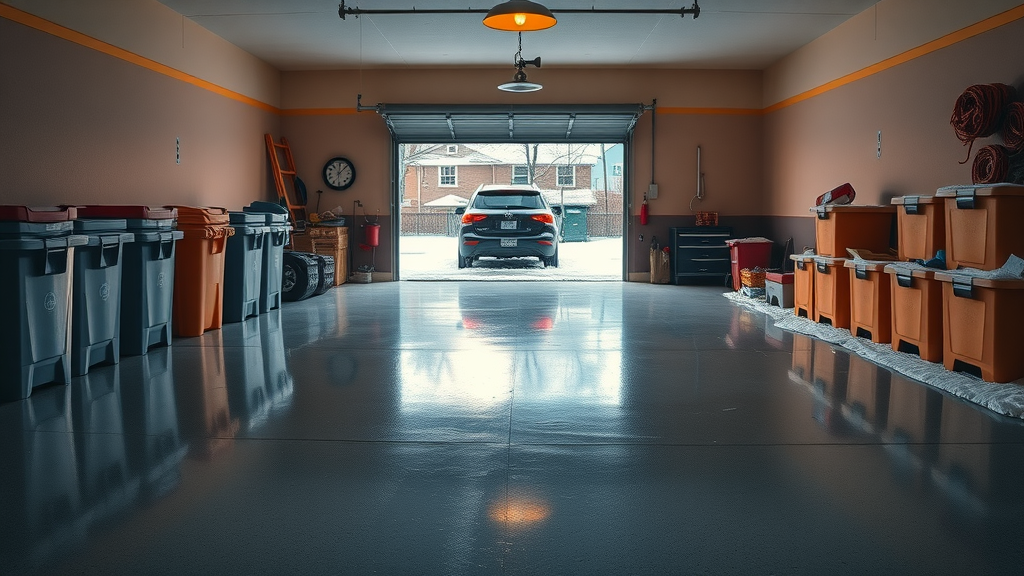
Conclusion: Secure Your Garage Today with Proactive Winter Garage Floor Care (Salt, Slush)
"Proactive winter garage floor care not only protects your investment—it keeps your garage safer and cleaner for your family year-round."
Ready for Winter? Call Us Now to Get Your FREE Quote! 800-280-9210
To effectively protect your garage floor from the damaging effects of winter salt and slush, consider implementing the following strategies:
-
Regular Cleaning: Promptly remove salt and slush to prevent them from seeping into the concrete. A recommended method involves using a solution of one cup of vinegar mixed with a gallon of warm water and a squirt of dish soap. Apply this mixture to the salt stains, let it sit for five minutes, scrub with a deck brush, and then remove the solution using a wet vacuum or mop. Rinse with clean water and repeat if necessary. (allgaragefloors.com)
-
Use of Protective Mats: Place heavy-duty mats or trays under vehicles to catch drips as snow melts. Mats with ridges or lips are particularly effective in containing moisture and preventing it from spreading across the garage floor. (thegarageguys.ca)
-
Application of Sealants or Coatings: Applying a sealant or specialized coating, such as epoxy or polyaspartic, adds a protective layer that blocks salt and moisture from penetrating the concrete surface. This proactive measure can significantly extend the lifespan of your garage floor. (thegarageguys.ca)
By incorporating these practices, you can maintain a clean and durable garage floor throughout the winter months, safeguarding it against the corrosive effects of salt and slush.
 Add Row
Add Row  Add
Add 

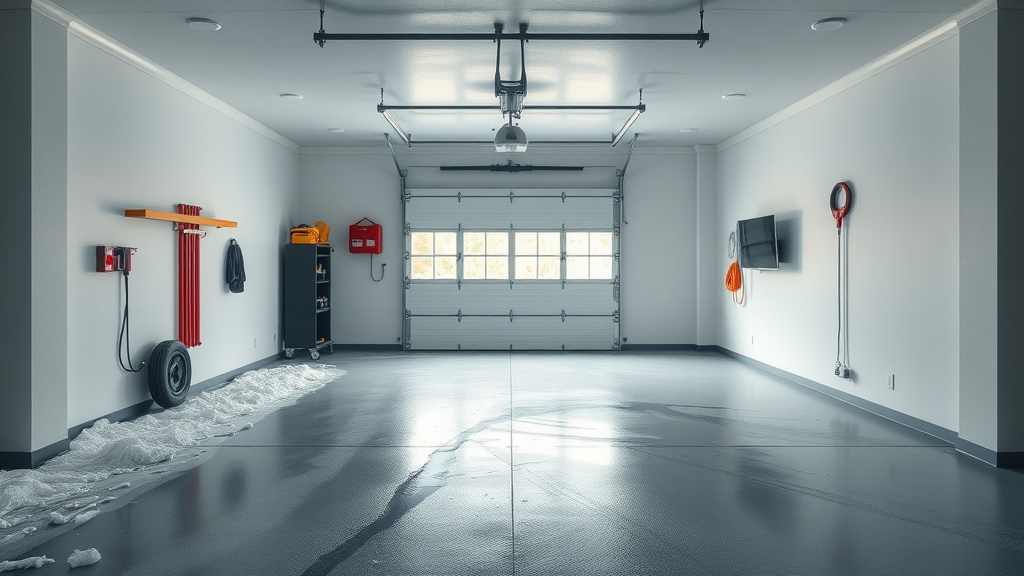

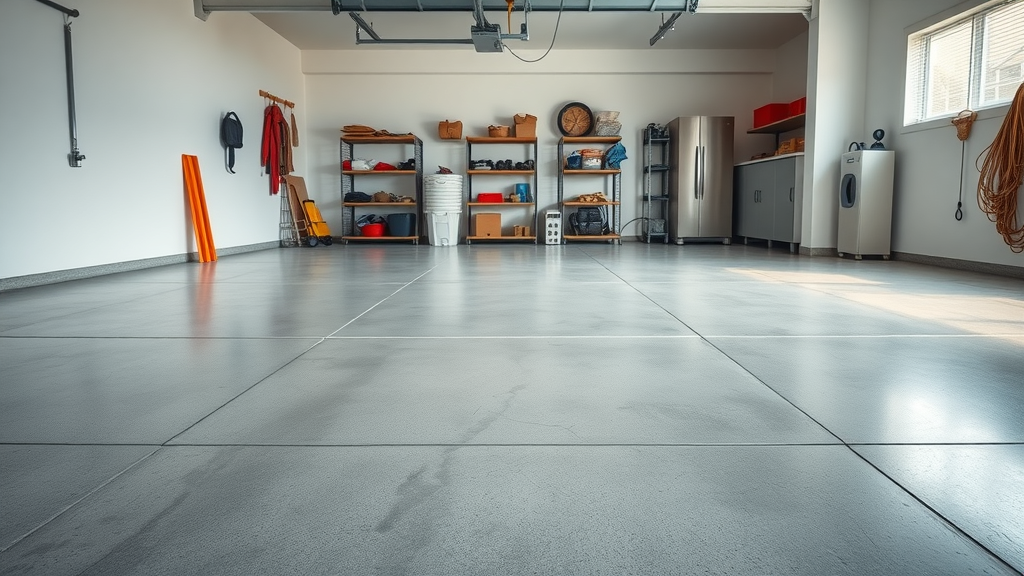
Write A Comment